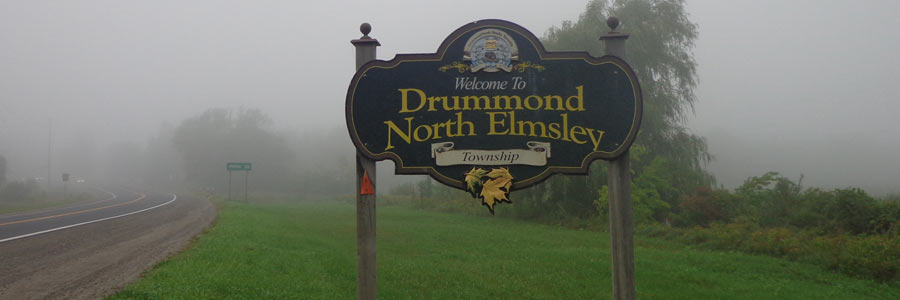Advanced Septic Systems Required Maintenance
Some properties will have advanced septic systems, also referred to as alternate systems, and tertiary units. These systems are different than conventional septic systems and can more effectively treat private sewage on small lots, in areas with high groundwater tables or other factors. Because of their advanced design, these systems are required under the Ontario Building Code to receive annual maintenance by a qualified and licensed contractor to ensure they continue to operate properly.
Please note section 8.9.2.3 of the Ontario Building Code states:
“(2) No person shall operate a treatment unit other than a septic tank unless the person has entered into an agreement whereby servicing and maintenance of the treatment unit and its related components will be carried out by the person who, . . . (b) Is authorized by the manufacturer to service and maintain that type of treatment unit.”
Property Owner’s Requirements for Advanced Septic Systems
You are responsible for the care and maintenance of your septic system. Your septic system is required by Ontario regulations to have a valid maintenance contract with a licensed manufacturer or service provider renewed each year.
Property owners must renew/renegotiate a service contract. Your service provider will inform us that your account is in good standing order, which means that it is clear of any service suspensions.
Please note that if change of property ownership occurs, the current property owner must disclose to the prospective purchaser the existing treatment unit contract and advise the service provider of the impending sale and the name of the new owner.
What Steps Can I Take to Ensure My Septic System Functions Properly?
A sewage system which has been properly installed, should, with proper care and maintenance provide many years of service. There are, however, some things which individuals need to be aware of which will help the system function properly.
- Avoid putting the following into a septic system:
- Fats, oils and grease
- Gasoline, antifreeze
- Varnishes, paints and solvents
- Caustic drain and harsh cleaners
- Photographic solutions, bleach, pesticides
- Nail polish remover
- Cat box litter
- Tampons, sanitary napkins, diapers, paper towels, condoms
- Plastics
- Coffee grounds, eggshells and other kitchen waste
- Direct roof drains, sump water and surface water away from the sewage system.
- Discharge water from softeners and iron filters should not be directed into the sewage system unless the system has been designed to accept such discharges.
- Water usage in the home should be kept to a minimum. Excessive use, such as doing numerous loads of laundry in one day, could flush solids from the treatment unit (septic tank) into the leaching bed.
- There should be no need to use “starters”, “bacterial feeds” or “cleaners”.
- The treatment unit should be inspected at regular intervals and pumped out whenever sludge and scum occupy 1/3 of the working capacity of the tank. Because they contain deadly gases, septic tanks should only be inspected by firms specializing in this work.
- Vehicular traffic (including snowmobiles) should not be allowed over the leaching bed.
- The area over a leaching bed should have a good cover of grass allowing for adequate sunlight and ventilation to be maintained. Avoid planting shrubs and trees over this area.
How Can I Recognize If My Septic System is Having Problems?
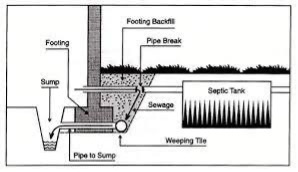
This diagram depicts sanitary sewage effluent that is being picked up in the perimeter weeping tile surrounding the house and is being drained into the internal sump pit in the building. This may indicate a break in the pipe between the building and the tank, which would cause the sanitary sewage to leak into the foundation backfill and into the weeping tile.
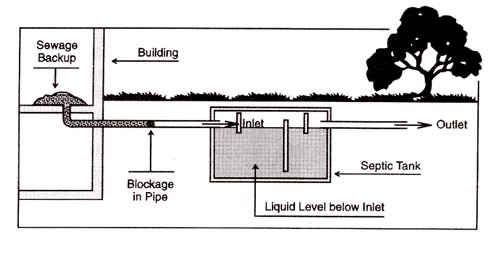
A cause of sanitary sewage backup into a building is blockage of the pipes in the sanitary sewage system. If the sewage is backing up into the building the septic tank must be opened and examined. If the liquid level in the tank is below the level of the inlet pipe, then there is a blockage between the building and the inlet of the tank. A plumbing contractor can remove this type of blockage using a plumbing snake.
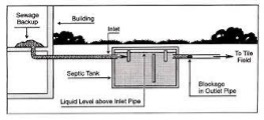
If the level of sanitary sewage in the tank is above the inlet pipe, the blockage is on the outlet side of the tank and may be in the tile bed. A high level of sewage within the tank could also indicate that the entire leaching bed is saturated and that the ground can no longer absorb the liquid.
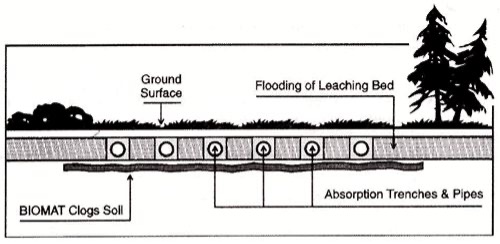
The saturation of a leaching bed is one of the most serious causes of malfunction of a septic system. Saturation occurs when the receiving soil surrounding the leaching bed cannot accept any more effluent. Blockage is usually caused by clogging of the soil by the Biomat which is created under the tile trench.

